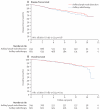Radiotherapy or surgery of the axilla after a positive sentinel node in breast cancer (EORTC 10981-22023 AMAROS): a randomised, multicentre, open-label, phase 3 non-inferiority trial
- PMID: 25439688
- PMCID: PMC4291166
- DOI: 10.1016/S1470-2045(14)70460-7
Radiotherapy or surgery of the axilla after a positive sentinel node in breast cancer (EORTC 10981-22023 AMAROS): a randomised, multicentre, open-label, phase 3 non-inferiority trial
Abstract
Background: If treatment of the axilla is indicated in patients with breast cancer who have a positive sentinel node, axillary lymph node dissection is the present standard. Although axillary lymph node dissection provides excellent regional control, it is associated with harmful side-effects. We aimed to assess whether axillary radiotherapy provides comparable regional control with fewer side-effects.
Methods: Patients with T1-2 primary breast cancer and no palpable lymphadenopathy were enrolled in the randomised, multicentre, open-label, phase 3 non-inferiority EORTC 10981-22023 AMAROS trial. Patients were randomly assigned (1:1) by a computer-generated allocation schedule to receive either axillary lymph node dissection or axillary radiotherapy in case of a positive sentinel node, stratified by institution. The primary endpoint was non-inferiority of 5-year axillary recurrence, considered to be not more than 4% for the axillary radiotherapy group compared with an expected 2% in the axillary lymph node dissection group. Analyses were by intention to treat and per protocol. The AMAROS trial is registered with ClinicalTrials.gov, number NCT00014612.
Findings: Between Feb 19, 2001, and April 29, 2010, 4823 patients were enrolled at 34 centres from nine European countries, of whom 4806 were eligible for randomisation. 2402 patients were randomly assigned to receive axillary lymph node dissection and 2404 to receive axillary radiotherapy. Of the 1425 patients with a positive sentinel node, 744 had been randomly assigned to axillary lymph node dissection and 681 to axillary radiotherapy; these patients constituted the intention-to-treat population. Median follow-up was 6·1 years (IQR 4·1-8·0) for the patients with positive sentinel lymph nodes. In the axillary lymph node dissection group, 220 (33%) of 672 patients who underwent axillary lymph node dissection had additional positive nodes. Axillary recurrence occurred in four of 744 patients in the axillary lymph node dissection group and seven of 681 in the axillary radiotherapy group. 5-year axillary recurrence was 0·43% (95% CI 0·00-0·92) after axillary lymph node dissection versus 1·19% (0·31-2·08) after axillary radiotherapy. The planned non-inferiority test was underpowered because of the low number of events. The one-sided 95% CI for the underpowered non-inferiority test on the hazard ratio was 0·00-5·27, with a non-inferiority margin of 2. Lymphoedema in the ipsilateral arm was noted significantly more often after axillary lymph node dissection than after axillary radiotherapy at 1 year, 3 years, and 5 years.
Interpretation: Axillary lymph node dissection and axillary radiotherapy after a positive sentinel node provide excellent and comparable axillary control for patients with T1-2 primary breast cancer and no palpable lymphadenopathy. Axillary radiotherapy results in significantly less morbidity.
Funding: EORTC Charitable Trust.
Copyright © 2014 Elsevier Ltd. All rights reserved.
Figures


Comment in
-
How do the AMAROS trial results change practice?Lancet Oncol. 2014 Nov;15(12):1280-1. doi: 10.1016/S1470-2045(14)71018-6. Epub 2014 Oct 15. Lancet Oncol. 2014. PMID: 25439680 No abstract available.
-
Radiotherapy or surgery for the axilla in node-positive breast cancer?Lancet Oncol. 2015 Feb;16(2):e53. doi: 10.1016/S1470-2045(14)71134-9. Lancet Oncol. 2015. PMID: 25638679 No abstract available.
-
Radiotherapy or surgery for the axilla in node-positive breast cancer?Lancet Oncol. 2015 Feb;16(2):e53-4. doi: 10.1016/S1470-2045(14)71219-7. Lancet Oncol. 2015. PMID: 25638680 No abstract available.
-
Radiotherapy or surgery for the axilla in node-positive breast cancer?--authors' reply.Lancet Oncol. 2015 Feb;16(2):e54. doi: 10.1016/S1470-2045(15)70008-2. Lancet Oncol. 2015. PMID: 25638681 No abstract available.
-
AMAROS Study: Overall Survival in Breast Cancer Subtypes.Clin Oncol (R Coll Radiol). 2015 Aug;27(8):485-6. doi: 10.1016/j.clon.2015.04.002. Epub 2015 May 1. Clin Oncol (R Coll Radiol). 2015. PMID: 25936629 No abstract available.
References
-
- van der Ploeg IM, Nieweg OE, van Rijk MC, Valdes Olmos RA, Kroon BB. Axillary recurrence after a tumour-negative sentinel node biopsy in breast cancer patients: a systematic review and meta-analysis of the literature. Eur J Surg Oncol. 2008;34:1277–84. - PubMed
-
- Mansel RE, Fallowfield L, Kissin M, et al. Randomized multicenter trial of sentinel node biopsy versus standard axillary treatment in operable breast cancer: the ALMANAC trial. J Natl Cancer Inst. 2006;98:599–609. - PubMed
-
- Veronesi U, Paganelli G, Viale G, et al. A randomized comparison of sentinel-node biopsy with routine axillary dissection in breast cancer. N Engl J Med. 2003;349:546–53. - PubMed
Publication types
MeSH terms
Associated data
Grants and funding
LinkOut - more resources
Full Text Sources
Other Literature Sources
Medical
Miscellaneous

